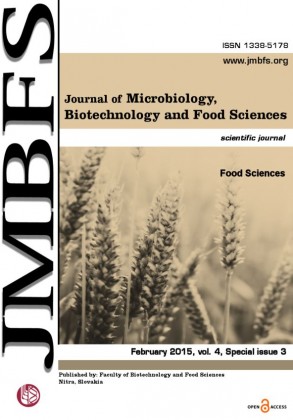THE CONTENT OF POLYPHENOLS IN FRUIT OF HIGHBUSH BLUEBERRY (VACCINIUM CORYMBOSUM L.) RELATING TO DIFFERENT FERTILIZER APPLICATION
DOI:
https://doi.org/10.15414/jmbfs.2015.4.special3.109-113Keywords:
cultivars, blueberry, polyphenol, organic fertilizer, mineral fertilizerAbstract
Six varieties of high blueberries (Vaccinium corymbosum L.) grown on a plantation of research station in Krivá, that is located in the northern part of Slovakia, was examined to determine the content of polyphenols in the fruit depending on the three variants of fertilization. The first variant was realized with the application of organic fertilization, second one with mineral fertilizers and third variant was left without fertilization. The content of total polyphenols (TP) was determined spectrophotometrically using Folin-Ciocalteau reagent. The total polyphenol content ranged from 2522.90 mg.kg-1 to 4960.20 mg.kg-1 in the variant with organic fertilization. In the variant with mineral fertilization the total polyphenol content ranged from 2278.25 mg.kg-1 to 3350.23 mg.kg-1. In the variant without fertilization was concentration of total polyphenols from 2503.63 mg.kg-1 to 3790.48 mg.kg-1. Statistical evaluation of the results confirmed a very weak correlation between polyphenols and one variety of different fertilization on the level of significance (p <0.05). Statistically significant effect on the level of significance (p <0.05) in Tukey's test was confirmed at the Patriot variety of organic and mineral fertilization and the mineral fertilization and control variant.Downloads
Download data is not yet available.
Downloads
Published
2015-02-02
How to Cite
Medvecký, M., Daniel, J., Vollmannová, A., Zupka, S., & Kopernická, M. (2015). THE CONTENT OF POLYPHENOLS IN FRUIT OF HIGHBUSH BLUEBERRY (VACCINIUM CORYMBOSUM L.) RELATING TO DIFFERENT FERTILIZER APPLICATION. Journal of Microbiology, Biotechnology and Food Sciences, 4(special issue 3 (Food Sciences), 109–113. https://doi.org/10.15414/jmbfs.2015.4.special3.109-113
Issue
Section
Food Sciences
License
Copyright (c) 2015 Michal Medvecký, Ján Daniel, Alena Vollmannová, Stanislav Zupka, Miriama Kopernická

This work is licensed under a Creative Commons Attribution 4.0 International License.
All papers published in the Journal of Microbiology, Biotechnology and Food Sciences are published under a CC-BY licence (CC-BY 4.0). Published materials can be shared (copy and redistribute the material in any medium or format) and adapted (remix, transform, and build upon the material for any purpose, even commercially) with specifying the author(s).





